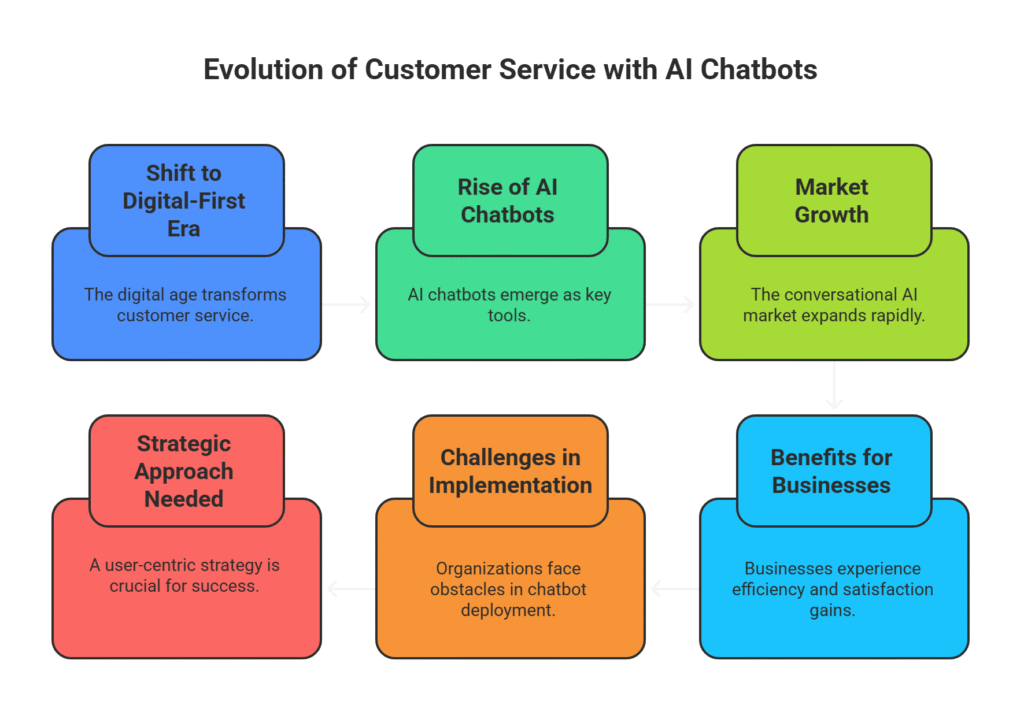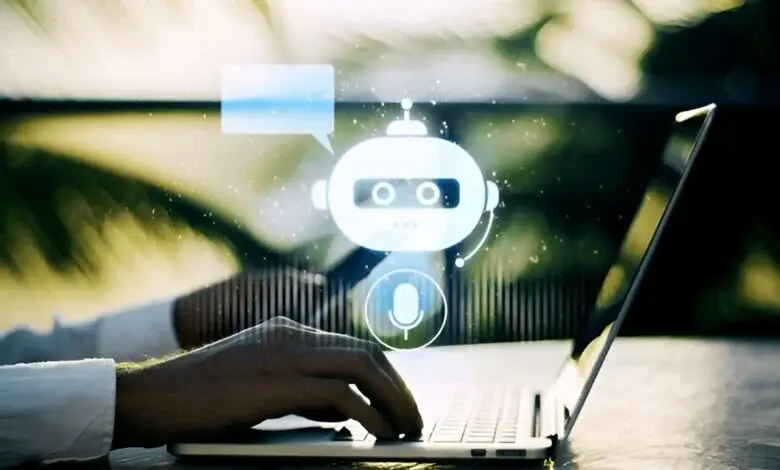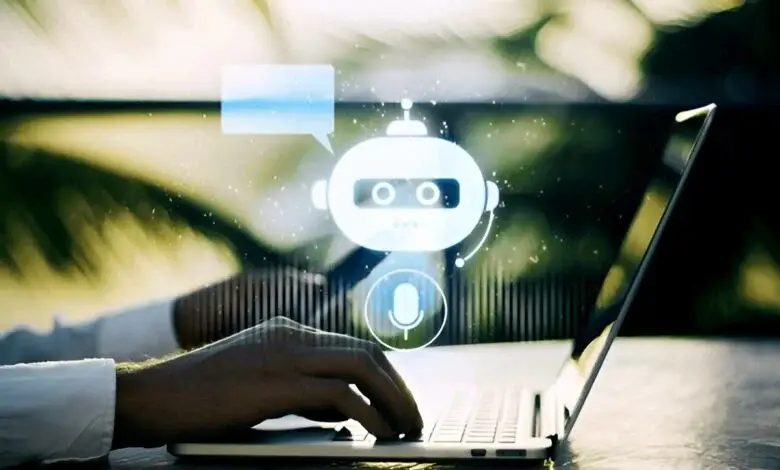In the digital-first era, the landscape of customer service has undergone a seismic shift. Gone are the days of long hold times and limited support hours. Today’s consumers demand instant, accessible, and personalized assistance. At the forefront of this revolution are AI-powered chatbots, evolving from simple query-and-response tools into sophisticated conversational architects capable of transforming the customer experience. This article delves into the intricacies of building effective chatbots, exploring the challenges, strategies, and future possibilities that define success in this dynamic field.
The meteoric rise of chatbots is not just a fleeting trend; it’s a fundamental reshaping of how businesses interact with their clientele. The market for conversational AI is booming, with projections indicating a multi-billion dollar valuation in the coming years. This surge is fueled by the undeniable value proposition that well-implemented chatbots offer: 24/7 availability, instantaneous responses, and the ability to handle a vast number of inquiries simultaneously. For businesses, this translates into increased efficiency, reduced operational costs, and, most importantly, a significant boost in customer satisfaction.
However, the path to a successful chatbot implementation is not without its obstacles. Many organizations have encountered frustrations, deploying bots that are more of a hindrance than a help. The key to avoiding these pitfalls lies in a strategic, well-thought-out approach that prioritizes the user experience above all else. This comprehensive guide will illuminate the path forward, providing a blueprint for creating a chatbot that not only meets but exceeds customer expectations.

Overcoming the Implementation Maze: Common Challenges and Their Solutions
The journey to an effective customer service chatbot is often fraught with challenges that can derail even the most well-intentioned projects. Understanding these potential roadblocks is the first step toward overcoming them.
One of the most significant hurdles is understanding customer intent. A chatbot that repeatedly misunderstands or provides irrelevant answers is a recipe for frustration. This often stems from a lack of high-quality training data or a poorly designed natural language processing (NLP) model. The solution lies in a meticulous data collection and annotation process. Businesses must invest in gathering real customer inquiries and accurately labeling them to train the chatbot’s AI. Furthermore, employing advanced NLP techniques and continuously refining the model based on user interactions are crucial for improving intent recognition over time.
Another critical challenge is seamless integration with existing systems. A chatbot that operates in a silo, unable to access customer data or escalate issues to a human agent, has limited utility. To be truly effective, a chatbot must be integrated with the company’s CRM, inventory management, and other relevant backend systems. This allows for a more personalized and context-aware conversation. For instance, a chatbot integrated with a CRM can access a customer’s purchase history and provide tailored recommendations. The key to successful integration is a robust API strategy and a clear understanding of the data flows between different systems.
Data security and privacy are also paramount concerns, especially in an age of heightened awareness around data protection regulations like GDPR. Chatbots often handle sensitive customer information, making it imperative to have stringent security measures in place. This includes end-to-end encryption, secure data storage, and compliance with all relevant regulations. Transparency with users about what data is being collected and how it is being used is also essential for building trust.
Finally, many businesses struggle with measuring the value and ROI of their chatbot initiatives. Without clear metrics, it’s difficult to justify the investment and make data-driven improvements. To address this, organizations must define key performance indicators (KPIs) from the outset. These can include metrics like customer satisfaction scores (CSAT), first-contact resolution rates, and the number of inquiries deflected from human agents. Regularly tracking these KPIs will provide valuable insights into the chatbot’s performance and help identify areas for optimization.
The Blueprint for Success: Crafting a High-Performing Customer Service Chatbot
Building an effective chatbot is a multifaceted process that requires a strategic blend of technology, data, and human oversight. Here are the essential pillars for constructing a chatbot that delivers a superior customer experience.
The foundation of any powerful chatbot is comprehensive training with company-specific knowledge. A generic, off-the-shelf chatbot will not suffice. To provide accurate and relevant information, the chatbot must be trained on a company’s knowledge base, including FAQs, product manuals, and policy documents. This ensures that the chatbot can answer a wide range of questions with confidence and precision. Furthermore, the training data should be regularly updated to reflect any changes in products, services, or policies.
A crucial element of a successful chatbot strategy is the ability to facilitate a seamless handover to a human agent. There will always be complex or sensitive issues that require a human touch. A well-designed chatbot should be able to recognize when it has reached the limits of its capabilities and gracefully escalate the conversation to a human agent. This handover process should be frictionless, with the chatbot providing the human agent with a complete transcript of the conversation so that the customer does not have to repeat themselves.
Personalization is another key differentiator. In a competitive market, a generic, one-size-fits-all approach is no longer effective. By leveraging customer data, chatbots can deliver a highly personalized experience. This can include addressing the customer by name, referencing their past interactions, and providing tailored recommendations. Personalization not only improves customer satisfaction but also fosters a sense of loyalty and connection with the brand.
Continuous testing and refinement are the lifeblood of an effective chatbot. A chatbot is not a “set it and forget it” solution. It requires ongoing monitoring and optimization to ensure that it is meeting its objectives. This includes regularly reviewing conversation logs to identify areas where the chatbot is struggling, conducting A/B testing to experiment with different conversation flows, and soliciting feedback from users. By embracing a culture of continuous improvement, businesses can ensure that their chatbot remains a valuable asset over the long term.
The Future of Customer Conversations: The Rise of Advanced AI Agents
The evolution of chatbots is far from over. The next frontier is the emergence of advanced AI agents that are capable of handling even more complex tasks and providing proactive, data-driven insights. These AI agents will be able to understand context more deeply, engage in more natural and empathetic conversations, and even anticipate customer needs before they are explicitly stated.
One of the key advancements driving this evolution is the development of more sophisticated AI models, such as large language models (LLMs). These models are trained on vast amounts of text and code, enabling them to generate more human-like and contextually relevant responses. As these models continue to improve, we can expect to see AI agents that are virtually indistinguishable from their human counterparts.
The future of customer service will likely involve a hybrid model, where AI agents and human agents work in tandem to deliver a seamless and exceptional customer experience. AI agents will handle the majority of routine inquiries, freeing up human agents to focus on more complex and high-value interactions. This collaborative approach will not only improve efficiency but also lead to a more engaged and empowered workforce.
In conclusion, building an effective chatbot for customer service is a strategic imperative for any business looking to thrive in the digital age. By understanding the common challenges, embracing a blueprint for success, and keeping an eye on the future, organizations can create a chatbot that not only resolves customer inquiries but also builds lasting relationships. The journey may be complex, but the rewards—in the form of increased customer satisfaction, loyalty, and business growth—are well worth the effort. The architect of conversation is no longer human alone; it is a powerful synergy of human ingenuity and artificial intelligence, working together to create a better customer experience for all.
The Architect of Conversation: Building Effective Chatbots for a Superior Customer Service Experience
In an era of instant gratification, the gold standard for customer service is no longer just about resolving issues—it’s about providing immediate, personalized, and effortless support. Enter the AI-powered chatbot, a transformative tool that is reshaping the landscape of customer interactions. No longer relegated to clunky, pre-programmed responses, today’s chatbots are sophisticated conversationalists, capable of understanding intent, personalizing interactions, and seamlessly integrating with human support. This article delves into the intricacies of building effective chatbots that not only meet but exceed customer expectations, driving satisfaction and fostering loyalty.
The Indispensable Role of Chatbots in Modern Customer Service
The meteoric rise of chatbots in customer service is not a fleeting trend; it’s a fundamental shift in how businesses engage with their clientele. The benefits are compelling and multifaceted, impacting everything from operational efficiency to customer sentiment.
At its core, the most significant advantage of a well-implemented chatbot is the provision of 24/7 support. In our globalized, always-on world, customers expect assistance outside of traditional business hours. Chatbots effortlessly fill this gap, providing instant answers to common queries, troubleshooting basic issues, and guiding users through processes at any time of day or night. This constant availability not only enhances the customer experience but also significantly reduces the burden on human agents, freeing them to tackle more complex and nuanced inquiries.
Furthermore, chatbots are masters of efficiency and scalability. They can handle a virtually unlimited number of conversations simultaneously, a feat impossible for even the most adept human team. This scalability is particularly crucial during peak periods or unexpected surges in customer inquiries, ensuring that every customer receives a prompt response. By automating repetitive and time-consuming tasks, businesses can optimize their resource allocation, leading to substantial cost savings and a more streamlined support operation.
Beyond the operational advantages, a thoughtfully designed chatbot can be a powerful tool for enhancing customer engagement and personalization. By integrating with CRM systems and leveraging customer data, chatbots can offer tailored recommendations, provide proactive support, and remember past interactions. This level of personalization makes customers feel understood and valued, transforming a simple support interaction into a positive brand experience. The ability to gather real-time feedback through these interactions also provides businesses with invaluable insights into customer needs and pain points, driving continuous improvement across products and services.
However, the journey to a successful chatbot implementation is not without its hurdles. Many organizations grapple with challenges such as accurately understanding customer intent, ensuring data security and privacy, and seamlessly integrating the chatbot with existing systems. Overcoming these obstacles requires a strategic and well-thought-out approach to chatbot development, a blueprint for which we will explore in the next section.
Blueprint for Success: How to Build a High-Performing Customer Service Chatbot
Creating a chatbot that genuinely enhances the customer experience is a meticulous process that extends far beyond simply deploying a piece of software. It requires a deep understanding of your customers, a clear definition of your goals, and a commitment to continuous improvement.

1. Define Your Purpose and Scope: Before a single line of code is written, it is paramount to define the chatbot’s primary function. Will it be a first line of defense for frequently asked questions? Will it assist with order tracking and returns? Or will it have more advanced capabilities like lead qualification or appointment scheduling? A clearly defined scope ensures that the chatbot is focused and effective in its designated role. Start with a few key use cases and expand its capabilities over time as you gather data and insights.
2. Choose the Right Technology Stack: The market is awash with chatbot development platforms, each offering a different set of features and capabilities. The choice of technology will depend on your specific needs, technical expertise, and budget. For simpler, FAQ-based chatbots, a no-code or low-code platform might suffice. For more complex, AI-driven chatbots that require natural language processing (NLP) and machine learning capabilities, a more advanced framework or a custom build may be necessary. Consider factors such as integration capabilities, scalability, and the level of customization offered.
3. Train Your Chatbot with Quality Data: A chatbot is only as intelligent as the data it’s trained on. To ensure your chatbot can understand and respond to customer queries accurately, it needs to be fed a rich and relevant dataset. This can include historical chat logs, customer service emails, knowledge base articles, and product documentation. The more comprehensive and well-structured the training data, the better the chatbot’s ability to grasp context, recognize intent, and provide helpful responses.
4. Design a Natural and Intuitive Conversational Flow: The user experience is paramount. The conversation should feel natural and intuitive, guiding the user towards a resolution without causing frustration. Map out the conversational flow for various scenarios, anticipating potential user questions and providing clear and concise responses. Incorporate elements like quick reply buttons and carousels to make the interaction more engaging and efficient. Crucially, always provide a clear and easy way for the user to escalate to a human agent. This “human handover” is a critical safety net for complex or sensitive issues and builds trust with your customers.
5. Prioritize Personalization: Generic, one-size-fits-all responses are the hallmark of a poor chatbot experience. Leverage customer data to personalize the conversation. Greet users by their name, reference their order history, and tailor recommendations based on their past interactions. This personal touch demonstrates that you value your customers as individuals and can significantly enhance their perception of your brand.
6. Rigorous Testing and Iteration: Before unleashing your chatbot on your entire customer base, it’s essential to conduct thorough testing. This includes testing for accuracy, understanding of different phrasings of the same question, and the overall user experience. Involve a diverse group of testers to identify potential issues and gather feedback. The launch of your chatbot is not the finish line; it’s the beginning of a continuous cycle of improvement. Regularly analyze conversation logs, identify areas where the chatbot struggles, and use this data to refine its responses and expand its knowledge base.
The Future is Now: Advanced Chatbot Strategies and a Look Ahead
The evolution of chatbots is far from over. The future promises even more sophisticated and intelligent conversational agents that will further revolutionize the customer service landscape.
The Rise of the AI Agent: The next generation of chatbots is evolving into true “AI agents.” These are not just reactive responders but proactive problem-solvers. Powered by advanced AI and machine learning, these agents can anticipate customer needs, initiate conversations, and perform complex tasks across multiple systems. Imagine a chatbot that not only answers a question about a delayed delivery but also proactively reschedules it and offers a discount for the inconvenience, all without human intervention. This level of autonomy will empower businesses to provide an even more seamless and efficient customer experience.
Hyper-Personalization at Scale: As data analytics capabilities become more advanced, the potential for hyper-personalization will grow exponentially. Future chatbots will be able to understand not just what a customer is asking, but also their sentiment and emotional state. This will allow for more empathetic and contextually aware responses, fostering a deeper connection between the customer and the brand.
The Symbiotic Relationship Between Humans and AI: The future of customer service is not about replacing humans with chatbots, but about creating a symbiotic relationship between the two. Chatbots will handle the routine and repetitive, while human agents will focus on high-value, emotionally complex interactions. This collaborative approach will empower support teams to be more strategic and effective, ultimately leading to a more satisfying experience for both customers and employees.
In conclusion, building an effective chatbot for customer service is a strategic imperative for any business looking to thrive in the digital age. By focusing on a clear purpose, leveraging the right technology, and committing to continuous improvement, you can create a conversational experience that not only resolves issues but also builds lasting relationships with your customers. The era of the intelligent, helpful, and personable chatbot is here, and the businesses that embrace it will undoubtedly lead the way in customer service excellence.



